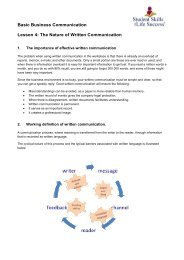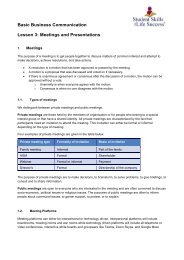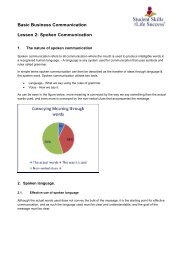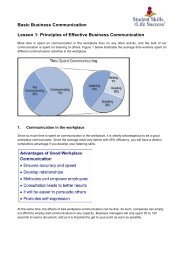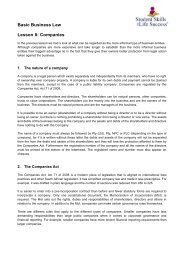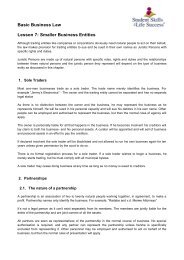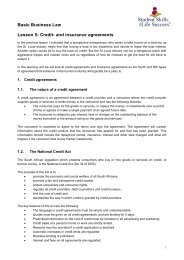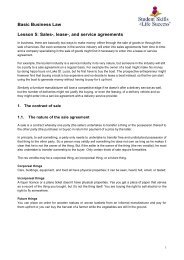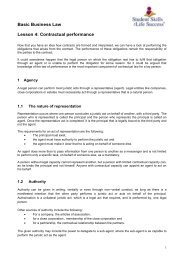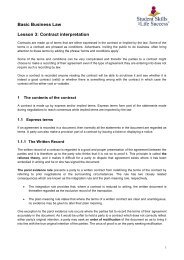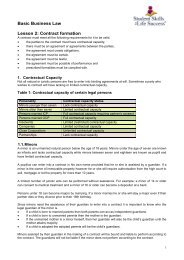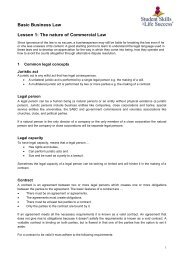Basic Business Law. Lesson 9. Payment
This is the ninth lesson of the "Student Skills for Life Success" "Basic Business Law" course. The topics covered in this booklet are: 1. Legal Tender 2. Cheques 3. Credit Cards 4. EFT's
This is the ninth lesson of the "Student Skills for Life Success" "Basic Business Law" course. The topics covered in this booklet are:
1. Legal Tender
2. Cheques
3. Credit Cards
4. EFT's
You also want an ePaper? Increase the reach of your titles
YUMPU automatically turns print PDFs into web optimized ePapers that Google loves.
<strong>Basic</strong> <strong>Business</strong> <strong>Law</strong><br />
<strong>Lesson</strong> 9: <strong>Payment</strong><br />
We all pay for goods and services on a daily basis and expect payment in return for our labour, contributions<br />
or even ideas, but rarely stop to think what this concept of payment really entail. <strong>Payment</strong> can be described<br />
as the transfer of money from one legal person to another, in exchange for the provision of goods and/or<br />
services or to fulfil a legal obligation.<br />
The oldest form of payment is barter. Barter is the exchange of a thing or a service for another thing or<br />
service. While there is nothing that stops you from bartering, today payment is more likely to take place<br />
through money, cheques, debit- and credit cards or bank transfers. In this lesson we are looking at these<br />
payment methods and some other negotiable instruments. A negotiable instrument is something that can be<br />
used to effect payment.<br />
1. Legal Tender<br />
Legal tender refers to banknotes or coin that may be legally offered in payment of an obligation and that a<br />
creditor is obliged to accept.<br />
The only contractual relationship will be that between the person owing the money debt (the debtor) and the<br />
person who is owed payment (the creditor)<br />
Debtor<br />
Creditor<br />
Any amount in banknotes may be offered for payment.<br />
In the case of coin, the acceptable amount per individual transactions is equal to the total amount, not<br />
exceeding the following:<br />
Nominations<br />
Limit Amount<br />
R1, R2 and R5 coins R50.00<br />
50, 20 and 10 cent coins R5<br />
Coins of 5c or less<br />
50c<br />
The Reserve Bank is liable for the legal tender of payment of an amount equal to the amount specified on<br />
the banknote, while the value of each coin tendered is equal to the amount specified on that coin.<br />
In the case of gold coin, the Bank will purchase such coin at the value of that which the South African<br />
Reserve Bank is willing to pay for gold coin on the day of such tender.<br />
The creditor can insist on the precise sum being paid and cannot be made to give change, while the debtor<br />
is entitled to a receipt and can withhold payment until he receives one. If a debt is expressed in foreign<br />
currency, the creditor can demand that the debtor pay and the debtor can insist on paying, in South African<br />
currency.<br />
Only an un-defaced and un-mutilated banknote or coin, which is lawfully in circulation, is legal tender. A<br />
banknote is mutilated when its condition is damaged by deterioration, fire or when it has been torn, defaced<br />
or has missing portions. Such banknote requires a special examination in order to determine its face value.
A coin is mutilated when its condition is damaged by deterioration, fire or when it<br />
has been partially destroyed. A bank is not obliged to make any payment in<br />
respect of a coin which, in the opinion of the bank, is mutilated or worn away and which may be tendered to<br />
it, but may, in its discretion, make a payment in respect of such coin. It is an offence to wilfully mutilate coin<br />
Although it is an offence to deface a banknote, the South African Reserve Bank allows the use of devices<br />
that deface banknotes as a means to deter robberies and theft.<br />
The Government has given the South African Reserve Bank (SARB) the sole right to issue banknotes and<br />
coin in the country. However, all new designs of banknotes and coin must have the prior approval of the<br />
Government before it is placed into circulation<br />
The SARB must ensure that sufficient new banknotes and coin are available to replace banknotes, which are<br />
removed from circulation due to soil levels.<br />
In the commercial sphere other instruments are commonly used to execute payment of a money debt. The<br />
use of these instruments often means that another party enters into the transaction.<br />
2. <strong>Payment</strong> by cheque<br />
<strong>Payment</strong> by cheque is conditional upon the cheque being paid on presentation to the bank on which the<br />
cheque is drawn. Only once the cheque is honoured by the bank, the debtor is discharged.<br />
In order to pay by cheque the person paying by cheque (the drawer) need to have a contractual relationship<br />
with a bank (the drawee). The person being paid by cheque is known as the payee. There need not be a<br />
contractual relationship between the drawee and the payee.<br />
Drawer<br />
Payee<br />
Drawee<br />
A cheque is a signed, written instruction you give your bank to pay money out of your account. Who can<br />
receive payment on your cheques, depends on how you make out the cheque.<br />
It is against the law to accept a post-dated cheque as an initial payment or initial rental in terms of a credit<br />
agreement. A post-dated cheque is a cheque with a future date on it. It means that you cannot cash the<br />
cheque or pay it into a bank account before the date on the cheque.<br />
Example<br />
Mountain climber Manfred decides to hire a small cottage in the Drakensberg from which to conduct<br />
mountain hikes. He is not allowed to pay the lessor the first payment, the deposit, by way of a post-dated<br />
cheque, but there is nothing that stops him from giving the lessor 12 post-dated cheques for the lease of the<br />
cottage for the rest of the year. In fact doing this might be the easiest way to pay for someone who is far from<br />
a bank and not necessary available on the day the payment becomes due.
2.1. Transferable cheques<br />
There are three types of transferable cheques, namely bearer cheques, order cheques and cash cheques.<br />
These cheques can be passed on (transferred) by the person to whom the cheque is made out to another<br />
person, who then becomes entitled to receive payment on the cheque.<br />
If you make a cheque out to “JP Smith or bearer”, your instruction is for the bank to pay JP Smith or any<br />
other person who gets hold of the cheque and presents it for payment. - The words “or bearer” are often preprinted<br />
on the cheque. It’s important to exercise great care when handling a completed cheque which is<br />
payable to bearer, because it is as good as cash and anyone in possession of the cheque can receive<br />
payment<br />
If you make a cheque out to “JP Smith” and cross out the words “or bearer” – or if you make it out to “JP<br />
Smith or order” – your instruction is for the bank to pay JP Smith or anyone else to whom JP Smith may sign<br />
over the cheque, or to whom the person receiving the cheque from JP Smith may in turn sign over the<br />
cheque, and so on.<br />
With the exception of a cash cheque, if you cross out the words “or bearer” which have been pre-printed on<br />
the cheque form, the cheque automatically becomes payable to order. If you make the cheque out to “CASH”<br />
it is payable to anyone who comes into possession to the cheque, even if he words “or order” appear on the<br />
cheque.<br />
2.2. Non-transferable cheques<br />
If you make the cheque out to “JP Smith” and mark the cheque “NOT TRASFERABLE”, your instruction is<br />
that only JP Smith may be paid.<br />
By marking your cheque “NOT TRANSFERABLE” boldly across its face, you will have a claim against a bank<br />
if it negligently pays the cheque to the wrong person. If you make the cheque payable to “JP Smith only” or, if<br />
the words “not transferable” are not bold enough, the cheque is still not transferable, but you will not have a<br />
claim against a bank that pays the wrong person.<br />
Once you have marked a cheque with the words “NOT TRANSFERABLE” you may not cancel these words,<br />
and any attempted cancellation should be ignored.<br />
If you make your cheque “not transferable”, make sure that you make it out in the full and correctly spelled<br />
the name of the person you want to pay. You must also ensure that this person has a bank account in that<br />
name. Banks may reject the cheque if you misspell the name of the payee, or if in the case of a company<br />
you use the trade name instead of its correct registered name.<br />
2.3. Crossed cheques<br />
A cheque is crossed by drawing two diagonal lines across the face of the cheque near the top left corner. If a<br />
cheque is not crossed, a person can receive payment in cash across the counter. A crossed cheque can only<br />
be paid into a bank account.<br />
This means that the person to whom the cheque is made out (the “payee”) must have a bank account into<br />
which the money can be paid. Crossed cheques help to prevent fraud, since it is usually possible to trace the<br />
person to whom the cheque has been paid. - It is not permitted to cancel a crossing.
Crossed cheques marked “not negotiable”.<br />
If you cross the cheque and write on it the words “NOT NEGOTIABLE”, the<br />
person to whom the cheque has been made out may still transfer the cheque to someone else. BUT, if the<br />
cheque gets stolen, the thief- or anyone taking the cheque from the thief – has no claim against you. This<br />
means that you can stop the cheque and nobody can successfully sue you for payment on the cheque.<br />
If your bank pays the cheque before you can stop it, the true owner (the payee or yourself) has the right to<br />
recover the loss from any person who came into possession of the cheque after the theft.<br />
It is recommended that you always cross your cheques, unless the person you are paying asks for a “cash”<br />
cheque or does not have a bank account. It is also recommended that you always mark crossed cheques<br />
“NOT NEGOTIABLE”, preferably between the crossing lines.<br />
Crossed cheques marked “not transferable” and “not negotiable”<br />
Even though the “NOT TRANSFERABLE” marking should ensure that no one other than the payee receives<br />
payment, the cheque may still come into the hands of someone who is not allowed to receive payment.<br />
The “NOT NEGOTIABLE” crossing brings about additional protection for the true owner of the cheque, by<br />
giving rights in certain circumstances against any other person who has been in possession of the cheque.<br />
The effect of different markings on a check<br />
Marking<br />
Effect<br />
No Marking<br />
Not-Transferable only<br />
Crossed Only<br />
Crossed and Not-Transferable<br />
Crossed and Not-Negotiable<br />
Crossed and Not-Transferable<br />
and Not-Negotiable<br />
The bank will pay anybody in possession of the cheque<br />
The bank will only pay the person who’s name is on the cheque<br />
The check can only be paid into a bank account<br />
The person who’s name is on the cheque can only pay the cheque into<br />
his own bank account<br />
The person in possession can pay it into his bank account if he is<br />
legally in possession of the cheque only<br />
The person who’s name is on the cheque can only pay the cheque into<br />
his own bank account if he is legally in possession of the cheque<br />
2.4. Duties of the drawee<br />
The bank must see to it that the drawer’s instructions are correctly carried out and must ensure that …<br />
• the drawer’s signature is on the cheque,<br />
• there are no obvious alterations on the cheque and<br />
• the cheque is not post-dated or stale (more than six months old).<br />
The bank where the cheque is deposited must ensure that the person depositing the cheque is allowed to<br />
receive payment.<br />
For example; a non-transferable cheque made out to “JP Smith” must only be paid out to JP Smith and a<br />
transferable cheque made payable to “JP Smith or order “ must either be paid out to JP Smith or has a<br />
signature on the back indicating that the cheque has been made over to someone else.
2.5. Duties of the drawer<br />
Make out your cheques in such a way that they are not easy to alter. For example, if you leave blank spaces<br />
after a payee’s name, a cheque payable to “Mr Morgan” may be altered to become a cheque to “Mr Morgan<br />
Botha”. If you leave a space between “one hundred” and “rand” the cheque may become a cheque for “one<br />
hundred thousand rand”<br />
Do not abbreviate as this could lead to alterations and don’t be careless in leaving your chequebook lying<br />
around or giving other people the opportunity to forge your signature. Rather keep your chequebook locked<br />
away in a safe place when you don’t need it.<br />
Advise your bank as soon as possible if you suspect any fraud or loss.<br />
It is advisable to keep your chequebook separate from credit cards, ATM cards or other documents that<br />
contain your signature. If a thief gets hold of your cheque book, but does not know your normal signature,<br />
the forged signature will probably not resemble your signature at all, and your bank will be liable if it fails to<br />
pick up a bad forgery.<br />
2.6. Sending cheques through the mail<br />
Make sure that cheques sent through the mail are always crossed, made payable to a specified person and<br />
marked “not negotiable” between the crossing lines. You may wish to mark the cheque “NOT<br />
TRANSFERABLE”, but remember that a not transferable cheque cannot be used to pay someone who does<br />
not have a bank account.<br />
Do not use staples or paperclips to attach the cheque to a letter- it’s a good way of telling a thief that there’s<br />
a cheque inside the envelope.<br />
Complete the payee’s name correctly (which includes, in the case of a company, the addition of “(Pty) Ltd”<br />
or “Ltd” and, in the case of a close corporation, the designation “cc”).<br />
As an alternative, consider the benefits of paying your debts by means of the electronic account payment<br />
facilities offered by your bank.<br />
2.7. Travellers Cheques<br />
A Travellers Cheque is a pre-printed, fixed-amount cheque and is available in all major currencies. Trey can<br />
be bought from a bank or other financial provider who issues it.<br />
They have no expiry dates, but you are required to convert your unused Travellers Cheques to Rand within<br />
30 days of your return to South Africa.<br />
You have to sign your Travellers Cheques twice, first when you buy them and then again in the presence of<br />
the paying agent when you cash them or in the presence of the accepting business who accepts Travellers<br />
Cheques as direct payment. If the Travellers Cheques are in the currency of the visitor’s country they will<br />
have to cash them in at a paying agent, but if they are in Rand they can be spent directly for goods or<br />
services, where Travellers Cheques are accepted. The acceptor only need to watch the payer sign the<br />
cheques, compare the signatures, and give the right change.<br />
If a traveller’s cheque is lost or stolen, it will be replaced by the issuing financial institution if the payer was<br />
careful when using them. The prudent traveller must do the following:
• Present a passport when cashing Travellers Cheques.<br />
• Only countersign your cheques in the presence of the paying agent<br />
when you cash them or in the presence of the acceptor when you use them for payment.<br />
• Keep a record of the serial numbers in a different place from the cheques themselves.<br />
• Contact the issuing bank or institution immediately if your cheques are lost or stolen.<br />
• If acceptors have any questions, allow them to phone the issuing bank or institution.<br />
The use of Travellers Cheques has been in decline since the 1990s as alternatives, such as credit cards,<br />
debit cards and automated teller machines have become more widely available and service level<br />
agreements between banks have allowed their clients to use each other’s banking infrastructure.<br />
3. <strong>Payment</strong> by credit card<br />
Every time someone uses a credit card for payment a small loan is in fact given by the bank to the card<br />
holder. The supplier will deliver the goods or services to the card holder as if he was paid in cash. The card<br />
holder in return has to pay back the money to the bank. If the card holder doesn’t pay back the bank within a<br />
certain time (often 50 days) then interest becomes payable on the loan.<br />
When a credit card is used distinct contractual relationships are created between the three parties.<br />
A contractual relationship between the bank and the card holder is created.<br />
• The bank authorises the card holder to purchase goods/services from certain suppliers.<br />
• The card holder undertakes to pay the bank any amount paid by the bank to a supplier in respect of<br />
goods sold or services rendered to the card holder.<br />
A contractual relationship between the bank and the supplier is created.<br />
• The bank undertakes to pay for any goods/services purchased by the card holder<br />
• The supplier undertakes to sell goods/services to a valid card holder<br />
A contractual relationship between the supplier and the card holder is created.<br />
• The supplier agrees to sell goods to, or perform a service for, the card holder.<br />
• Should the bank not pay the supplier for any reason, the supplier has recourse to the card holder for<br />
the amount payable on the contract between them.<br />
Card Holder<br />
Holder<br />
Supplier<br />
Bank<br />
4. Letters of Credit<br />
Documentary credits are used in international transactions. It’s an arrangement whereby one bank (the<br />
issuing bank), on application by a customer, undertakes either to make payment itself to a third party, or to<br />
arrange payment to that party by another bank. The undertaking is to make payment against stipulated<br />
documents and only if the terms and conditions of the credit are complied with.
A letter of credit is a document issued by a financial institution, assuring payment<br />
to a seller of goods and/or services. The seller then seeks reimbursement from<br />
the buyer or from the buyer's bank. The document serves as a guarantee to the seller that it will be paid by<br />
the issuer of the letter of credit regardless of whether the buyer ultimately fails to pay. In this way, the risk<br />
that the buyer will fail to pay is transferred from the seller to the letter of credit's issuer. The letter of credit<br />
also insures that all the agreed upon standards and quality of goods are met by the supplier.<br />
Letters of credit are used primarily in international trade for large transactions between a supplier in one<br />
country and a customer in another. The parties to a letter of credit are the supplier, the issuing bank, of which<br />
the buyer is a client, and a confirming bank, of which the beneficiary is a client.<br />
Almost all letters of credit are irrevocable, i.e. cannot be amended or cancelled without the consent of the<br />
beneficiary, issuing bank, and confirming bank.<br />
Buyer<br />
Holder<br />
Supplier<br />
Issuing<br />
Bank<br />
Confirming<br />
Bank<br />
These types of transactions will also often involve a fifth party, namely a carrier in which case the following<br />
process will be followed<br />
Step 1: A contract is concluded between the buyer and the supplier.<br />
Step 2: The buyer's bank supplies a letter of credit to the seller.<br />
Step 3: The seller consigns the goods to a carrier in exchange for a bill of lading.<br />
Step 4: The seller provides the bill of lading to his bank in exchange for payment.<br />
Step 5: The seller's bank exchanges the bill of lading for payment from the buyer's bank.<br />
Step 6: The buyer's bank exchanges the bill of lading for payment from the buyer.<br />
Step 7: The buyer provides the bill of lading to the carrier and takes delivery of the goods.<br />
5. Electronic funds transfers<br />
Electronic funds transfer (EFT) is the electronic exchange or transfer of money from one account to another,<br />
either within a single financial institution or across multiple institutions, through computer-based systems like<br />
SARBLINK and SWIFT.<br />
EFT’s include all of the following payment methods:<br />
• A wire transfer can be made from one bank account to another bank account via the internet on a<br />
computer or a cell phone or at an automatic teller machine (ATM). The payer must arrange with<br />
his/her bank to enable internet or cell phone banking and will need the banking details of the payee<br />
in order to effect the payment.
• Cash can be paid in a cash office, such as “Western Union”. The cash<br />
office will charge a service fee and give the payer a receipt and a 10 digit<br />
control number (code). The payer will give to the control number to the payee, who can then go to<br />
any other branch of the cash office and claim the money on presentation of the code.<br />
• The payer can make a direct deposit payment into the account of the payee as is the case when<br />
companies pay their employees at the end of the month.<br />
• Cardholder-initiated transactions, like when the payee is using a payment card such as a credit or<br />
debit card are also EFT’s. Most providers of goods and services have a card machine at the till<br />
points that is linked to some electronic payment system. When using a debit card the business can<br />
debit the consumer's bank account in real time for payment for goods or services,<br />
• Some providers of goods and services are already linked to the different banks and their customers<br />
can pay their bills electronically when banking online. Examples of these providers are Municipalities<br />
and the SABC.<br />
The Reserve Bank provides an inter-bank settlement service for South African Banks called the South<br />
African Multiple Option Settlement (SAMOS) system. SAMOS is also used by major retailers who make big<br />
payments to banks on a daily basis. The SAMOS system is linked to the various participant banks, clearing<br />
systems and operators.





